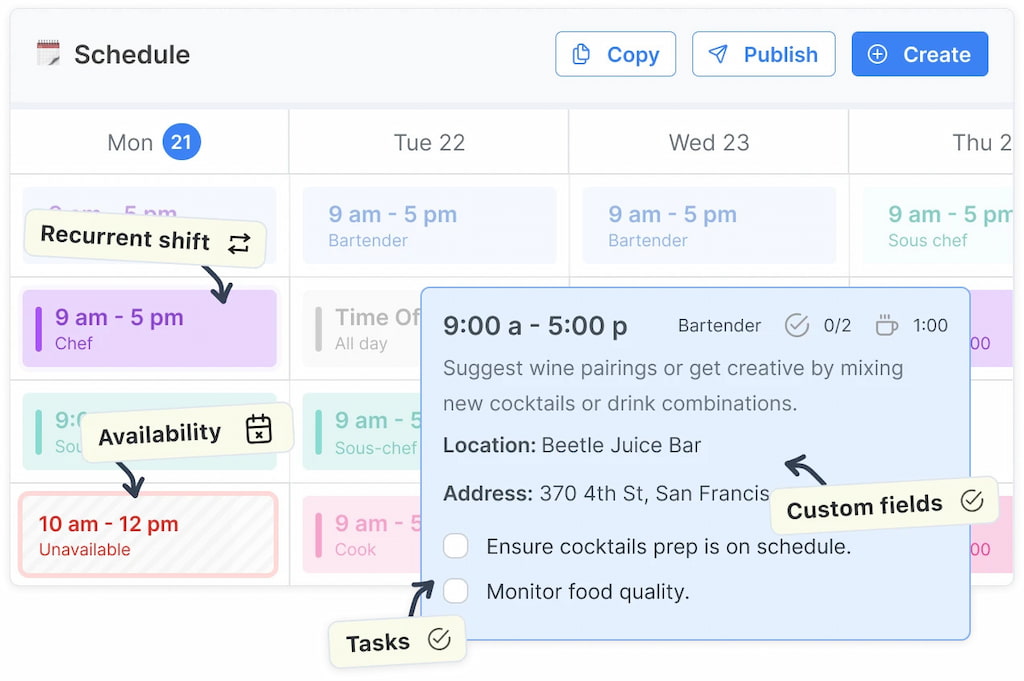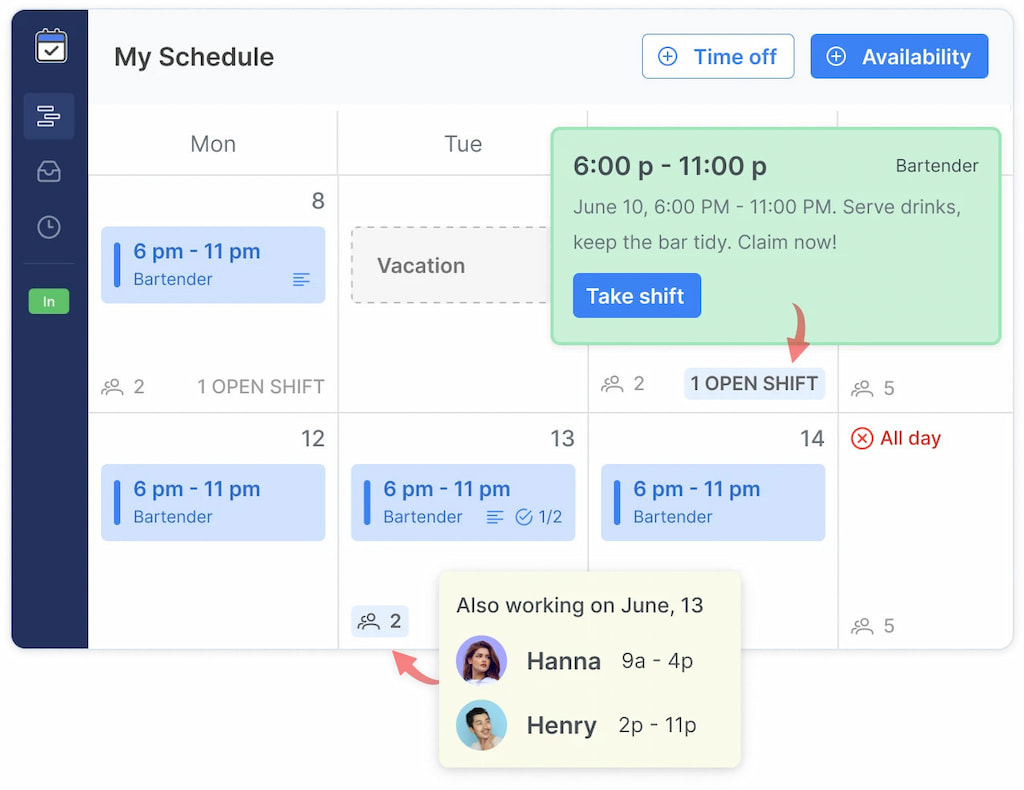Imagine a Monday morning where your team is ready to go—but three key people were assigned twice, two critical machines sit idle, and a high-value project has no one to lead it. In the race to meet deadlines, mismatches like these aren’t just inconvenient—they cost money, morale, and momentum. In this article you’ll learn how modern resource-scheduling software can turn that chaotic worksheet into a well-orchestrated flow of people, time, and machines. We’ll walk through what resource scheduling really means in 2025, how it drives efficiency, and the best free employee shift scheduling apps—including where Shifts by Everhour fits naturally.
🤔 What Is Resource Scheduling Software and Why It Matters in 2025
Resource scheduling software assigns and tracks resources—people, equipment, rooms, or time slots—to tasks and projects. The goal: ensure the right resource is in the right place at the right time, avoiding overload, conflicts, or wasted idle time. Why it matters in 2025:
- 🌍 Manage hybrid teams, remote workers, and physical assets across multiple sites.
- 💰 Pressure on margins makes this software essential, not optional.
- 🤖 Advanced analytics, AI forecasting, and system integration are now expected.
Resource scheduling software helps you:
- 📅 Visualize who or what is assigned where and when.
- 🔎 Identify bottlenecks or under-utilized assets.
- ⚖️ Align capacity with demand in real time.
- 📉 Reduce manual spreadsheets, errors, and over-booking.
🛠️ Key Features, Comparisons, and Use Cases
📊 Capacity & availability management
Track who or what is available and when. Example: a consultancy flags specialists nearing max billable hours or equipment booked for overlapping jobs.
Good software monitors availability, skills, and certifications, and blocks assignments that violate constraints.
⚠️ Assignment & conflict avoidance
Avoid double-booking people or equipment. Best-in-class tools warn of conflicts, enforce rules (max hours, required certifications), and allow drag-and-drop rescheduling. Example: a facilities firm reduced over-allocation by [Insert verified stat from Gartner or Capterra] percent.
🔮 Forecasting & what-if planning
Plan for unexpected changes—call-outs, machine downtime, or urgent tasks. Scenario planning and “what-if” simulations let teams spot gaps before they become problems. Example: a marketing agency tests the impact of a team member’s leave on upcoming campaigns.
📈 Real-time monitoring & reporting
Once live, see who’s working, idle, or overburdened. Dashboards show utilization, upcoming assignments, and deviations. Example: an architecture firm tracks actual vs planned hours to catch scope creep.
🔗 Integration & automation
Connect with HR, time tracking, project management, or procurement systems. Example: when a contractor clocks in, the schedule updates, approvals trigger, and overwork alerts fire. Shifts by Everhour shows how scheduling and tracking integrate seamlessly.
🚀 Where Shifts by Everhour Fits
Resource scheduling isn’t just about assigning shifts—it’s about managing people, time, and workload efficiently. Shifts by Everhour streamlines this process. Here’s how it helps:
- 🗓️ Visual schedule building: Drag-and-drop shifts, set availability, and track time off in one place.

- ⏱️ Live tracking: Clock in/out, log hours, and track breaks or attendance—all within the same app.
- 🔍 Transparent utilization: See idle staff, overworked shifts, and uncovered slots immediately.

- 📊 Actionable analytics: Know when asset usage drops or how many assignments go unfilled.
- 💡 Better ROI: Improved visibility, accountability, and resource optimization across your team.
In short: scheduling is no longer just planning—it’s ongoing management and optimization.
⚡ Best Practices / Actionable Tips
To turn software capabilities into real-world results, follow these field-tested practices:
- 🎯 Start small: Focus on one resource pool (e.g., field technicians) before expanding scheduling across teams.
- 📌 Define availability & constraints: Include skills, certifications, locations, and legal limits.
- 🗂️ Use templates & recurring patterns: Cuts schedule-building time and errors.
- 🕒 Require advance updates: Staff should update availability and shift preferences ahead of time for accuracy.
- 📊 Monitor utilization weekly: Idle capacity wastes money; over-capacity causes burnout.
- 🔄 Empower self-service: Allow workers to drop, swap, or pick up shifts under approval rules.
- 💼 Integrate with time tracking & payroll: Closing the loop ensures accurate data and cost control.
- 📈 Review post-mortem: Analyze missed assignments, underused resources, and recurring patterns for continuous improvement.
🧠 Comparison Table
| Tool | Key Features | Pricing/Plan | Ideal For |
| Shifts by Everhour | Drag-and-drop scheduling; unlimited groups; mobile clock-in/out; shift swaps; time-off requests; real-time alerts | Free & paid plans | Teams that want accurate rosters, real-time tracking and scheduling in one place |
| Resource Guru | Visual booking calendar; resource pools; utilisation analytics; mobile access; capacity heat-maps | Paid plans | Agencies, consultancies needing simple resource scheduling |
| Float | Project-based resource scheduling; forecasting; capacity vs demand views; team availability; integrations | Subscription | Creative and delivery teams managing cross-project assignments |
| 10,000ft Plans | High-level resource planning; scenario modelling; cost tracking; cross-project visibility | Paid plans | Enterprises needing strategic resource forecasting |
| Mavenlink | Resource matching; skill-based assignments; time tracking; financials; portfolio view | Enterprise licensing | Professional services firms needing full PSA suite |
| Monday.com | Custom workflows; resource dashboards; automation; mobile views; integrations | Free & paid tiers | Teams wanting flexibility and customizable scheduling flows |
| Smartsheet | Spreadsheet-style scheduling; resource views; dependencies; reporting; mobile app | Subscription | Organizations migrating from spreadsheets who want more power |
| ClickUp | Task & time tracking; resource view add-on; availability tagging; integrations | Free & paid plans | Smaller teams looking for combined task/time/resource solution |
| Teamdeck | Time & attendance; resource scheduling; leave management; utilisation reports | Paid plans | Field teams or agencies with hybrid scheduling/time tracking needs |
Tool highlights
- Shifts by Everhour: Best if you need scheduling + live time tracking in one clean system.
- Resource Guru: Visual, user-friendly, ideal for consultancies managing people across projects.
- Float: Excellent forecasting features for creative teams toggling between projects.
- 10,000ft Plans: Built for the high-level resource planner who needs “what-if” modelling.
- Mavenlink: Full professional-services automation suite—resource scheduling is part of a broader palette.
- Monday.com: Highly customizable, less scheduling-native but good for flexible workflows.
- Smartsheet: For teams still comfortable with spreadsheets but ready for real scheduling power.
- ClickUp: A hybrid tool—if scheduling is part of a broader task/time stack.
- Teamdeck: Combines scheduling and attendance/time tracking—best for frontline or field-based teams.
❓ FAQ Section
What’s the difference between “resource scheduling” and “shift scheduling”?
Shift scheduling focuses on assigning people to time slots in recurring patterns; resource scheduling covers any asset (people, machines, rooms) and often involves capacity, skills, forecasting and cross-project assignments.
How do I know if I need resource scheduling software?
If you frequently have over-booked staff, idle equipment, last-minute shifts, task assignments without clarity or schedule conflicts, software can help—many firms recover ROI within months.
Can I integrate scheduling software with time tracking or payroll?
Yes. Top tools like Shifts by Everhour integrate scheduling with time-in/out, breaks, time-off and often link into payroll or project cost systems—giving you one source of truth.
What should I prioritise when selecting resource scheduling software?
Look for ease of use, mobile access, conflict/availability rules, utilization reporting, integration potential (with your HR, time tracking or project systems) and cost transparency.
How long does it take to implement a resource scheduling tool?
For smaller teams it can be a few days to one week. Larger organisations may require 4-8 weeks of setup—defining resource pools, availability rules, integrations and training. Gradual rollout often works best.
Will scheduling software replace the human decision-maker?
No. The tool supports better decisions by providing visibility, conflict alerts and analytics—but human judgement and nuance remain key in assigning tasks, managing skills and interpreting exceptions.
🔎 Final Thoughts
In 2025, resource scheduling is no longer optional—it’s a strategic advantage. The tools available today go far beyond static calendars: they enable capacity planning, team empowerment, real-time visibility and cost control. When you select a tool, focus on clear criteria: resource definition, availability rules, scheduling ease, real-time tracking and integration with your broader systems. If you’re managing shifts, assignments, or time-based resources, consider looking at Shifts by Everhour—it offers clean scheduling, real-time tracking and mobile-friendly access, all in one flow. If managing assignments, resources or time still feels like herding cats, it may be worth giving it a try.
Don’t forget about tools that might already be at your disposal! ✅ Google Calendar shift scheduling makes team coordination faster and easier than ever.

